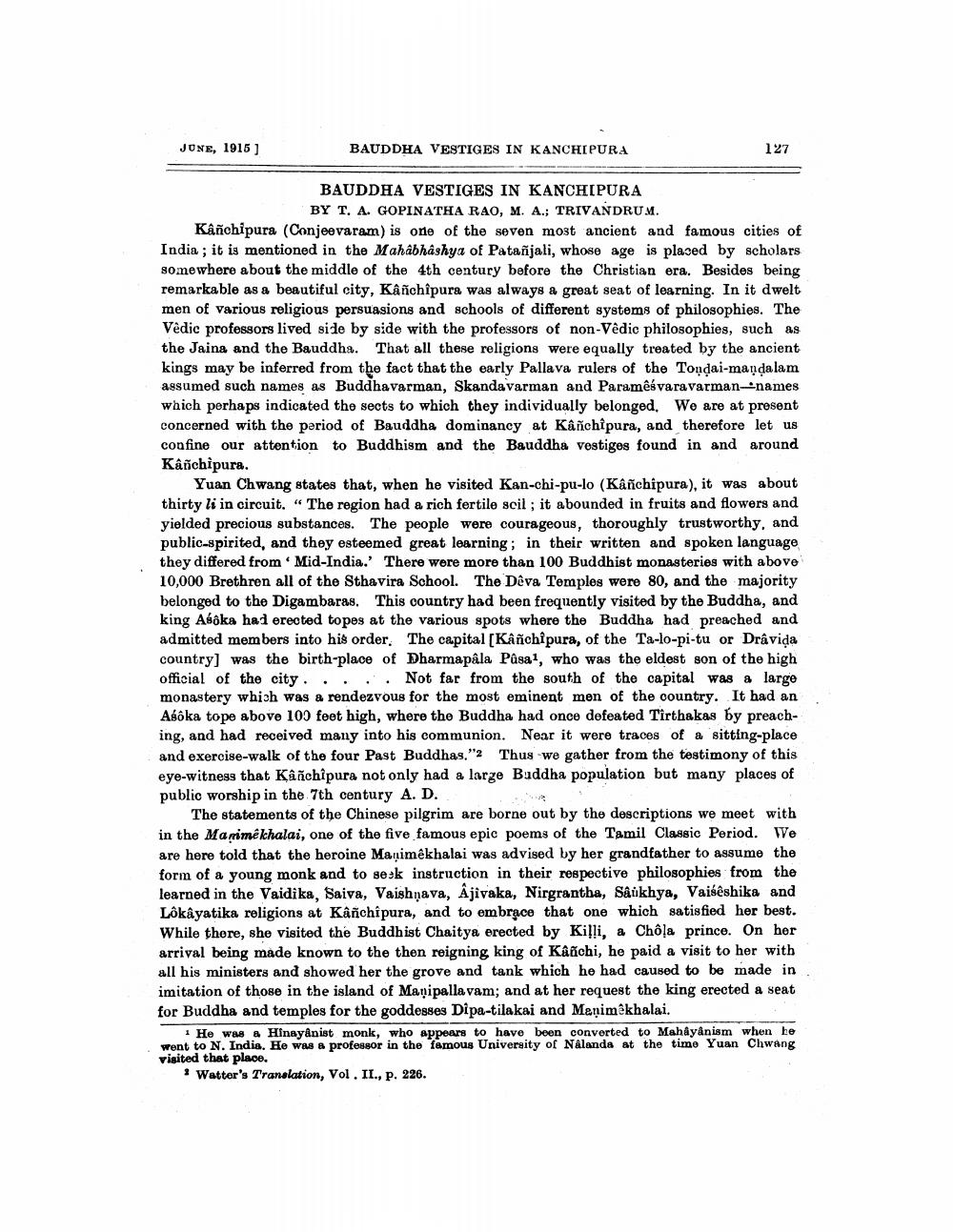________________
JONE, 1915 ]
BAUDDHA VESTIGES IN KANCHIPURA
127
BAUDDHA VESTIGES IN KANCHIPURA
BY T. A. GOPINATHA RAO, M. A.; TRIVANDRUM. Kanchipura (Conjeevaram) is one of the seven most ancient and famous cities of India; it is mentioned in the Mahâbhâshya of Patañjali, whose age is placed by scholars somewhere about the middle of the 4th century before the Christian era. Besides being remarkable as a beautiful city, Kanchipura was always a great seat of learning. In it dwelt men of various religious persuasions and schools of different systems of philosophies. The Vedic professors lived side by side with the professors of non-Vedic philosophies, such as the Jaina and the Bauddha. That all these religions were equally treated by the ancient kings may be inferred from the fact that the early Pallava rulers of the Tondai-mandalam assumed such names as Buddhavarman, Skandavarman and Paramêsvaravarman-names which perhaps indicated the sects to which they individually belonged. We are at present concerned with the period of Bauddha dominancy at Kanchipura, and therefore let us confine our attention to Buddhism and the Bauddha vestiges found in and around Kanchipura.
Yuan Chwang states that, when he visited Kan-chi-pu-lo (Kanchipura), it was about thirty li in circuit. “The region had a rich fertile scil; it abounded in fruits and flowers and yielded precious substances. The people were courageous, thoroughly trustworthy, and public-spirited, and they esteemed great learning; in their written and spoken language they differed from Mid-India. There were more than 100 Buddhist monasteries with above 10,000 Brethren all of the Sthavira School. The Dêva Temples were 80, and the majority belonged to the Digambaras. This country had been frequently visited by the Buddha, and king Asoka had erected topes at the various spots where the Buddha had preached and admitted members into his order. The capital [KAñchipura, of the Ta-lo-pi-tu or Dravida country] was the birth-place of Dharmapala Pâsal, who was the eldest son of the high official of the city. .. . Not far from the south of the capital was a large monastery which was a rendezvous for the most eminent men of the country. It had an Asoka tope above 100 feet high, where the Buddha had once defeated Tirthakas by preaching, and had received many into his communion. Near it were traces of a sitting-place and exercise-walk of the four Past Buddhas,"2 Thus we gather from the testimony of this eye-witness that Kanchipura not only had a large Buddha population but many places of public worship in the 7th century A. D.
The statements of the Chinese pilgrim are borne out by the descriptions we meet with in the Manimekhalai, one of the five famous epic poems of the Tamil Classic Period. We are here told that the heroine Manimêkhalai was advised by her grandfather to assume the form of a young monk and to sesk instruction in their respective philosophies from the learned in the Vaidika, Saiva, Vaishṇava, Ajivaka, Nirgrantha, Saukhya, Vaisêshika and Lôkâyatika religions at Kanchipura, and to embrace that one which satisfied her best. While there, she visited the Buddhist Chaitya erected by Killi, a Chôļa prince. On her arrival being made known to the then reigning king of Kanchi, he paid a visit to her with all his ministers and showed her the grove and tank which he had caused to be made in imitation of those in the island of Manipallavam; and at her request the king erected a seat for Buddha and temples for the goddesses Dipa-tilakai and Maạimêkhalai.
1 He was a Hinayanist monk, who appears to have been converted to Mahayanism when he went to N. India. He was a professor in the famous University of NÅlanda at the time Yuan Chwang visited that place.
? Watter's Translation, Vol. II., P. 226.




